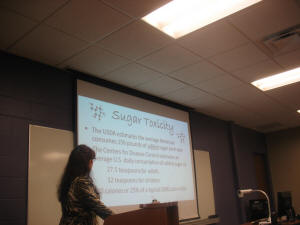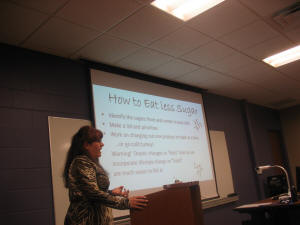|


Certified
Diabetes Educator Jennifer DiPasquale spoke on the topic “Sugar,
Sugar” with the objective of offering attendees a basic
understanding of how sugar and carbohydrates affect blood sugar, how
sugar affects the brain, how sugar deficiency affects you, how to
achieve sugar balance, and how to avoid sugar toxicity.

DiPasquale also provided sugar recommendations, discussed sugar
substitutes, and talked about how to decrease sugar intake.
DiPasquale has been a dietitian at ALMH for sixteen years and enjoys
helping people on their journey to health.
DiPasquale said sugar is a life sustaining chemical but can be
toxic. She explained how almost 100 percent of simple and complex
carbohydrates become blood sugar. Half of sugar alcohols become
blood sugar. Sugars include glucose, fructose, lactose and sucrose
also called table sugar.
DiPasquale said carbohydrates are the preferred fuel source for our
bodies. Cars use gas for fuel, and we use glucose. Simple sugars are
easy to digest. They provide quick energy like rocket fuel. In
fifteen to twenty minutes, the blood sugar goes down.
DiPasquale said one teaspoon equals four grams of sugar. Many
processed foods are full of sugar. Even half a cup of orange juice
has the equivalent of four teaspoons of sugar. Simple sugars include
table sugar, fruit juice, syrup, jelly, sherbet and candy, where all
calories are from sugar like lifesavers, smarties, gummy bears,
jelly beans, and gumdrops. They are also found in glucose tablets
and gels, which give people with diabetes get quick energy when
needed to raise blood sugar.
DiPasquale said sugar is needed to raise low blood glucose and get
quick energy after extended exercise. It is usually not needed
otherwise. DiPasquale said complex carbohydrates have many bonds to
break. The more fiber something has, the more complex it is. Fibers
slow down digestion, which slows down the rise of blood sugar.

Complex carbohydrates include whole grains like breads. Unprocessed
whole grains include buckwheat, bulgur, quinoa, barley and teff.
Other complex carbohydrates include starchy vegetables like
potatoes, corn, peas and legume beans. DiPasquale said complex
carbohydrates have much slower digestion and rise in blood sugar
than simple carbohydrates.

DiPasquale
explained that natural fruit and milk sugars are blood sugar
friendly when consumed in moderation. DiPasquale said we need to
avoid added sugars and more than minimally processed foods.
DiPasquale said sugar alcohols are used in place of other
carbohydrates and sugars to give food sweetness similar to table
sugar sweetness. Some examples used in place of sugar and found in
sugar free products include xylitol, sorbitol and mannitol.
DiPasquale said sugar affects brain chemistry because added sugars
lead to a dopamine release in the brain associated with reward and
motivation causing a sugar rush. MRI's have shown the response to
sugar is the same as the response to cocaine or heroin. The brain in
obese people responds to sugar like drug addicts and alcoholics to
their addictions.
DiPasquale
said the more sugar consumed, the less resistance you have. Sugar
induces cravings and a dependence on pleasure. Chronic high added
sugars in the diet reduce the production of brain derived
neurotrophic factor. This relationship is directly related to
difficulty learning, retaining, and remembering new information, and
is likely related to dementia and Alzheimer’s development.

[to top of second column] |

DiPasquale
said we need blood sugar, and our brain needs about 90-120 grams of
glucose a day. Glucose stores in the body are mostly used up after
six hours of fasting but may last two or three days for someone with
good muscle storage. When it is depleted after three days you enter
ketosis, burning fat for energy.
After three days of sugar deficiency, the brain must use stored fat.
The metabolism slows down to conserve energy and the brain adapts to
using only 30 grams of glucose by day four. Muscles are broken down
for energy needs. DiPasquale said ketogenic diets should be
medically monitored for these reasons.
DiPasquale said after carbohydrates are again consumed, normal
carbohydrate metabolism begins by immediately storing any excess
glucose from carbohydrates directly into fat cells. After
significant calorie or carbohydrate restriction, the body will
require fewer calories to meet needs.
DiPasquale promotes 90 percent or more better choices and just ten
percent or less NOT better choices.

The USDA
estimates the average American consumes about 156 pounds of added
sugar a year mostly due to an overabundance of processed foods. The
Centers for Disease Control estimates an average daily consumption
of added sugar of 27.5 teaspoons for adults and 32 teaspoons for
children.

Sugars should make up less than ten percent of calories according to
the Centers for Disease Control. The American Heart Association
recommends less than nine teaspoons added sugar daily for men and no
more than six for women and children daily.
DiPasquale said “sorta sugars” include low calorie and artificial
sweeteners and sugar substitutes. They are 100 to 400 times sweeter
than table sugars. Hyper-sweetness becomes normal, so natural sugars
may no longer satisfy our taste buds.
The packaging of sugar substitutes can guide natural choices. Green
and orange are naturally derived, while pink, blue, yellow are not.
Anything not natural that is made in a laboratory may be recognized
as foreign in the body, possibly triggering autoimmune responses or
allergies. DiPasquale said moderation is key.
DiPasquale said we need to look for hidden sugars on labels. These
include maltodextrin, dextrose, and corn syrup. The site
www.fooducate.com is a helpful place to find out more about added
versus natural sugars in our food products.
DiPasquale said it is important to identify added sugars front and
center in our diets, then prioritize decreasing them. She gave
several tips. Retrain taste buds by using unsweetened or pureed
fruit in cereal and yogurt and as bases in sauces and salad
dressings. Choose more fruit, vegetables, and whole grains. Eat more
unprocessed, high fiber, and high protein foods like nuts, seeds,
and nut or seed butters and legumes. Consume food Mind-FULLY.
Repackage the less healthy choices into single servings for
occasional use.

DiPasquale discussed an eating exercise to build a healthy
relationship with "trigger" foods and to remember that after three
bites, your taste buds are saturated, and you aren't getting the
full experience of that rich, sugary or fatty food.

DiPasquale
said it is good to work on changing one habit at a time. Small
simple changes add up. She warned that drastic changes or diets
without lifestyle changes or focus on habit changes are much more
likely to fail. Over time, though, we can learn to have a healthy
relationship with food and not a dependent one.
For more information, ask your physician for a referral to the ALMH
Dietitian Office for a Medical Nutrition Therapy consultation.
[Angela Reiners] |